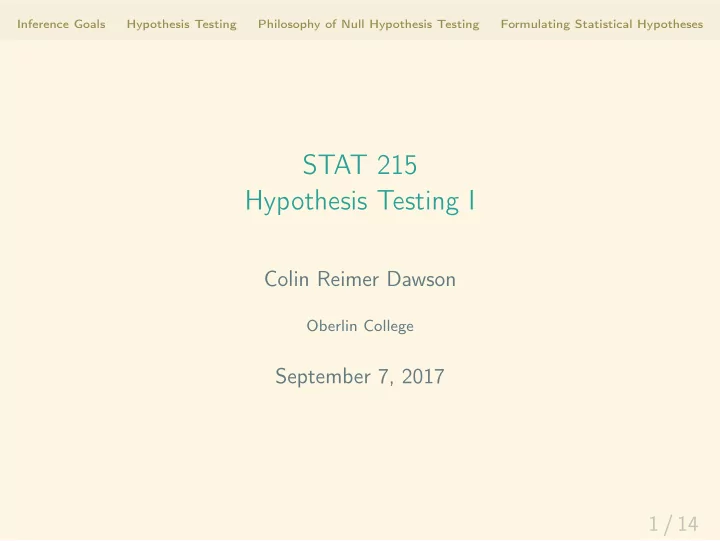

Inference Goals Hypothesis Testing Philosophy of Null Hypothesis Testing Formulating Statistical Hypotheses STAT 215 Hypothesis Testing I Colin Reimer Dawson Oberlin College September 7, 2017 1 / 14
Inference Goals Hypothesis Testing Philosophy of Null Hypothesis Testing Formulating Statistical Hypotheses Outline Inference Goals Hypothesis Testing Philosophy of Null Hypothesis Testing Formulating Statistical Hypotheses 2 / 14
Inference Goals Hypothesis Testing Philosophy of Null Hypothesis Testing Formulating Statistical Hypotheses Two Main Goals of Inference 1. Assessing strength of evidence about “yes/no” questions (hypothesis testing) 2. Estimating unknown quantities in a population using a sample (confidence intervals) 3 / 14
Inference Goals Hypothesis Testing Philosophy of Null Hypothesis Testing Formulating Statistical Hypotheses Outline Inference Goals Hypothesis Testing Philosophy of Null Hypothesis Testing Formulating Statistical Hypotheses 4 / 14
Inference Goals Hypothesis Testing Philosophy of Null Hypothesis Testing Formulating Statistical Hypotheses Hypothesis Testing Some (yes/no) questions we might want to answer with data: 1. Kidney stone treatment A has better outcomes than B in a sample of cases. Is A really more effective, or did those patients just get lucky? 2. Do people (in the population tip more (as a %) for more expensive restaurant meals? 3. Does the population of high school graduates earn more on average than the population of GED recipients? 5 / 14
Inference Goals Hypothesis Testing Philosophy of Null Hypothesis Testing Formulating Statistical Hypotheses In the 1920s in Cambridge, a lady claimed tea tasted different depending on whether the milk was added before or after the tea was poured. A scientist in attendance proposed to put it to a blind taste test w/ 10 cups of tea prepared in random order. • Is her claim plausible if she gets 5 of 10 correct? 10 of 10? 9 of 10? • How much success is enough to believe her? 6 / 14
Inference Goals Hypothesis Testing Philosophy of Null Hypothesis Testing Formulating Statistical Hypotheses Outline Inference Goals Hypothesis Testing Philosophy of Null Hypothesis Testing Formulating Statistical Hypotheses 7 / 14
Inference Goals Hypothesis Testing Philosophy of Null Hypothesis Testing Formulating Statistical Hypotheses Falsification Karl Popper: scientific theories can’t be fully verified (there is always another possible explanation), only falsified . 8 / 14
Inference Goals Hypothesis Testing Philosophy of Null Hypothesis Testing Formulating Statistical Hypotheses Falsification With Randomness • When sampling, we will occasionally get strange results just by chance. So we can’t falsify absolutely. • But we can say a hypothesis is implausible if the data would be very unlikely if the hypothesis were true. 9 / 14
Inference Goals Hypothesis Testing Philosophy of Null Hypothesis Testing Formulating Statistical Hypotheses The Null Hypothesis • R.A. Fisher: Formulate the negation of your research hypothesis, and establish conditions under which it can be rejected . • Fisher called this “antihypothesis” the null hypothesis , and developed null hypothesis significance testing (NHST). 10 / 14
Inference Goals Hypothesis Testing Philosophy of Null Hypothesis Testing Formulating Statistical Hypotheses The Alternative Hypothesis • Jerzy Neyman and Egon Pearson added the idea of the alternative hypothesis to Fisher’s null hypothesis formulation. • Idea: don’t reject H 0 in a vacuum — reject in favor of another hypothesis , the alternative hypothesis (or H 1 ). • This is usually the one you set out to investigate: the drug is better; the correlation is positive. 11 / 14
Inference Goals Hypothesis Testing Philosophy of Null Hypothesis Testing Formulating Statistical Hypotheses Outline Inference Goals Hypothesis Testing Philosophy of Null Hypothesis Testing Formulating Statistical Hypotheses 12 / 14
Inference Goals Hypothesis Testing Philosophy of Null Hypothesis Testing Formulating Statistical Hypotheses Statistics vs. Parameters • Summary values (like mean, median, standard deviation) can be computed for populations or for samples. • In a population, such a summary value is called a parameter • In a sample, these values are called statistics , and are used to estimate the corresponding parameter Value Population Parameter Sample Statistic ¯ Mean µ X Proportion p p ˆ Correlation ρ r ˆ Slope of a Line β 1 β 1 X 1 − ¯ ¯ Difference in Means µ 1 − µ 2 X 2 . . . . . . . . . 13 / 14
Inference Goals Hypothesis Testing Philosophy of Null Hypothesis Testing Formulating Statistical Hypotheses The Null and Alternative Hypothesis • Pairs/Threes (5 min.): Identify the relevant population parameter for each of the following claims. What are the null and alternative hypotheses (abbreviated H 0 and H 1 ), both in words and in terms of a population parameter? • The lady can tell the difference between cups of tea more often than random guessing. H 0 : p correct = 0 . 5 , H 1 : p correct > 0 . 5 , where p correct is her “long run” success rate • There is a positive linear association between pH and mercury in Florida lakes. H 0 : ρ = 0 , H 1 : ρ > 0 , where ρ is the correlation coefficient between pH and Hg in all Florida lakes • Lab mice eat more on average when the room is light. H 0 : µ light − µ dark = 0 , H 1 : µ light − µ dark > 0 , where µ are “long run”/population means for an appropriate measure of amount of food consumed 14 / 14
Recommend
More recommend